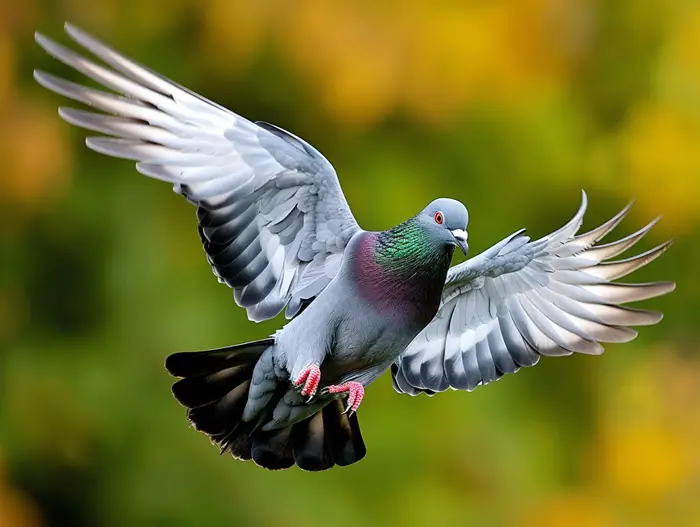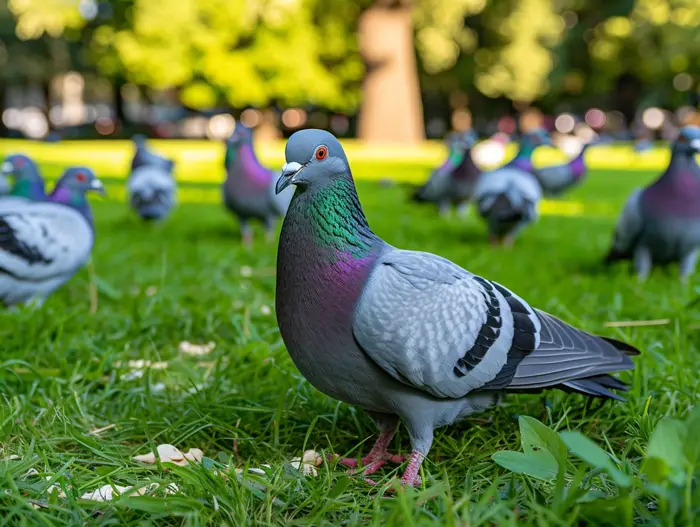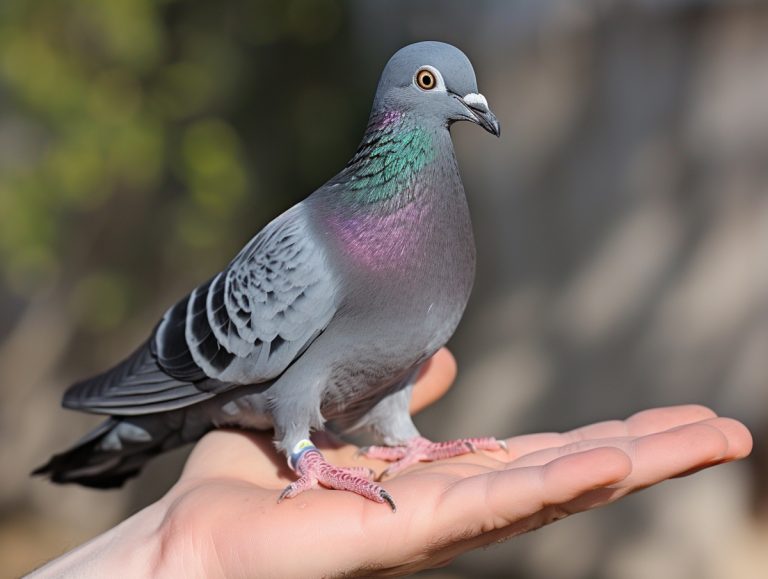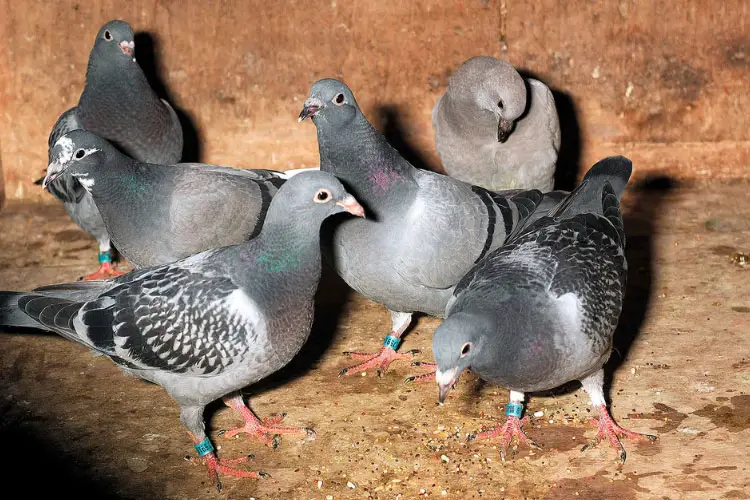Pigeon Body Parts: Feathered Wings and Remarkable Beaks
Pigeons, those fascinating creatures that grace our cities and parks, have a unique set of body parts that make them truly remarkable. From their sleek feathers to their nimble wings, pigeons are a marvel of nature’s design. In this article, I’ll take you on a journey to explore the various body parts of pigeons and uncover the secrets behind their incredible abilities.
First and foremost, let’s talk about those magnificent wings. Pigeons possess a pair of strong and flexible wings that enable them to soar through the skies with grace and precision. These wings are equipped with an intricate network of feathers, each serving a specific purpose in flight. Whether it’s gliding effortlessly or executing swift maneuvers, pigeons’ wings are truly a marvel to behold.
But it’s not just their wings that make pigeons extraordinary. Their beaks, too, play a crucial role in their survival and adaptation. Pigeons have a unique beak structure that allows them to efficiently forage for food. With a slender and pointed beak, they can easily pick up seeds and grains, while their small, sharp beaks enable them to delicately pluck insects and small invertebrates. The versatility of their beaks makes pigeons well-equipped to thrive in various environments.
The Magnificent Wings of Pigeons
Pigeons are incredible creatures that have a set of magnificent wings that enable them to navigate the skies with skill and precision. Let’s take a closer look at these remarkable body parts and their incredible abilities.

1. Strong and Flexible:
Pigeon wings are not only strong, but they’re also incredibly flexible. This allows pigeons to perform intricate maneuvers in flight, effortlessly gliding through the air. It’s truly a marvel to witness their agility and grace as they soar through the sky.
2. Intricate Feather Network:
One of the most fascinating aspects of pigeon wings is their intricate network of feathers. These feathers work together to provide the necessary lift and control during flight. The feathers are meticulously arranged in overlapping layers, creating a smooth surface that reduces drag and enhances maneuverability.
3. Versatile Flight:
Pigeons are capable of various flight styles, depending on their needs. They can effortlessly switch between soaring and flapping their wings to maintain altitude. This versatility enables them to navigate a wide range of environments, from urban areas to rural landscapes.
4. Remarkable Homing Instinct:
Another remarkable ability of pigeon wings is their role in the famous homing instinct. Pigeons have an innate ability to find their way back home from long distances, even if they are released in unfamiliar locations. It’s believed that their wings play a significant role in this navigational feat, allowing them to fly incredible distances with ease.
Pigeons’ wings truly are a marvel of nature. Their strength, flexibility, intricate feather network, and versatile flight abilities make them extraordinary creatures capable of thriving in various environments.
Uncovering the Secrets of Pigeons’ Wings
When it comes to the remarkable body parts of pigeons, their wings take center stage. Pigeon wings are truly fascinating, boasting a combination of strength, flexibility, and intricate design. Let’s delve into the secrets of these magnificent wings and discover what makes them so special.

Incredible Strength and Flexibility
Pigeon wings are exceptionally strong and flexible, allowing these birds to perform impressive aerial maneuvers. Their wings are made up of a complex network of bones, muscles, and tendons that work together to give them remarkable agility in flight. With their wings, pigeons can twist, turn, and change direction with ease, showcasing their mastery of the skies.
The Marvel of Feathered Wings
One of the key factors that contribute to the functionality of pigeon wings is their intricate covering of feathers. These feathers, arranged in precise patterns, provide lift and control, reducing drag and enhancing maneuverability. The design of these feathered wings is a work of art in itself, showcasing the exquisite beauty and engineering found in nature.
Versatile Flight Styles
Pigeons are known for their ability to navigate different environments, and their wings play a crucial role in this feat. These birds have the capability to employ various flight styles, adapting to different situations. Whether it’s soaring gracefully through the air, performing acrobatic maneuvers, or swiftly gliding over long distances, pigeons can effortlessly adapt their flight to suit their needs.
The Wings’ Role in Homing Instinct
Perhaps one of the most remarkable aspects of pigeon wings is their contribution to the birds’ homing instinct. Pigeons have an extraordinary ability to find their way back home from great distances, and their wings play a significant role in this feat. The intricate structure of their wings enables them to navigate and orient themselves accurately, allowing them to return to their roosting spot without hesitation.
The wings of pigeons are nothing short of extraordinary. With their strength, flexibility, and incredible feathered design, these wings enable pigeons to perform intricate aerial maneuvers, adapt to different flight styles, and navigate vast distances with their remarkable homing instinct. Truly, the wings of pigeons are a marvel of nature’s engineering prowess.
Pigeon Wings at a Glance
- Wings provide strength and flexibility for maneuverability
- Intricate feather design enhances lift and control
- Pigeons can employ various flight styles to adapt to
The Intricate Feathers that Enable Pigeons to Fly
When it comes to flying, pigeons have an incredible advantage – their intricate feathers. These feathers are specially designed to provide lift, control, and enhance maneuverability for these remarkable birds.
Pigeon feathers are not just any ordinary feathers. They form a complex network of overlapping vanes that create a smooth and aerodynamic surface. This structure helps reduce drag, allowing pigeons to soar through the air with ease.
One of the unique features of pigeon feathers is their ability to lock together. This helps maintain a streamlined shape during flight, which is crucial for reducing turbulence and increasing efficiency. These feathers are so well-designed that they even have small hooks called barbules, which keep the feathers interlocked and prevent them from separating.

The arrangement of feathers on pigeon wings is also worth mentioning. The primary feathers, located at the tip of the wing, provide the majority of the lift. These longer and stronger feathers are responsible for generating the necessary thrust for takeoff and maintaining altitude during flight. The secondary feathers, on the other hand, contribute to stability and control.
The color and pattern of pigeon feathers are not just for aesthetic purposes, but also serve practical functions. The patterns and shades help pigeons blend into their surroundings, providing camouflage from predators. Additionally, certain feathers have specialized features, such as down feathers that provide insulation and keep the birds warm.
Pigeon feathers are marvels of design and functionality. Their intricate structure, locking mechanism, and distribution on the wings enable these birds to perform extraordinary aerial maneuvers and navigate their environments with precision. The importance of feathers in the overall flight and survival of pigeons cannot be overstated. Next, let’s delve into the remarkable navigational abilities of these incredible birds.
The Remarkable Maneuvers of Pigeons in Flight
Flying is the most remarkable ability of pigeons. As they take to the skies, their maneuvers are nothing short of astounding. Let me tell you about some of the incredible ways in which pigeons navigate the skies.

1. Soaring and Gliding: Pigeons are masters of utilizing air currents to their advantage. They can soar effortlessly, catching rising columns of warm air called thermals. By gliding in these thermals, they conserve energy and stay aloft for extended periods of time.
2. Sharp Turns and Spirals: Pigeons have the remarkable agility to make sharp turns and spirals in flight. Whether they are avoiding obstacles or trying to confuse predators, pigeons can change direction swiftly and gracefully.
3. Acrobatic Flips: Have you ever seen a pigeon perform an aerial flip? It is truly mesmerizing. Pigeons can execute stunning aerial acrobatics, flipping and diving in mid-air. These flips are not only visually impressive but also serve as a means of communication among pigeons.
4. Precision Navigation: Pigeons possess an extraordinary sense of direction. They have the ability to navigate over long distances, sometimes even hundreds of miles, and make their way back to their home roost. Scientists believe that pigeons use a combination of the Earth’s magnetic field, landmarks, and their keen visual abilities to find their way.
5. Speedy Flight: Pigeons may not be the fastest birds in the sky, but they can still reach impressive speeds. They can fly at an average speed of 40 to 50 miles per hour. This allows them to cover large distances efficiently and quickly.
6. Aerial Communication: Pigeons have a unique way of communicating while in flight. They produce distinct cooing sounds to convey information to other pigeons. These vocalizations help pigeons establish territory, attract mates, and coordinate movements within a flock.
Pigeons truly are remarkable creatures when it comes to their maneuvers in flight. From soaring and gliding to acrobatic flips and precision navigation, these birds exhibit an impressive range of skills in the air. It’s no wonder they have captivated humans throughout history.
The Unique Beak Structure of Pigeons
When it comes to remarkable body parts, the beak of a pigeon deserves special attention. Pigeons have a unique beak structure that is perfectly adapted to their needs. Let’s delve into the fascinating world of pigeon beaks and explore what makes them so special.
First and foremost, the beak of a pigeon is designed to be flexible and versatile. It is made up of two halves that can move independently of each other, allowing the bird to have precise control over its beak movements. This flexibility comes in handy when pigeons need to perform delicate tasks such as picking up small objects or grooming their feathers.
Another interesting feature of pigeon beaks is their serrated edges. These tiny serrations act like a built-in cutting tool, making it easier for pigeons to grip and cut through their food. Whether it’s pecking at seeds or tearing apart fruits, the serrated edges of their beaks make the task efficient and effortless.
Pigeon beaks also vary in size and shape, depending on the specific needs of the bird. Some pigeons have shorter beaks, which allow them to efficiently crack open hard-shelled seeds. Others have longer beaks that are ideal for reaching deep into flowers to extract nectar. This adaptability in beak size and shape enables pigeons to take advantage of a wide range of food sources in their environment.
Moreover, the beak of a pigeon is not just a tool for feeding. It also plays a crucial role in communication. Pigeons use their beaks to coo and make distinct sounds that are unique to their species. This vocalization serves as a form of communication between pigeons, allowing them to convey important messages such as territory boundaries or mating calls.
The beak of a pigeon is a marvel of nature. Its flexibility, serrated edges, adaptability, and communication functions make it a truly remarkable body part. Without a doubt, the beak is an essential tool for a pigeon’s survival and success in the world.
The Versatility of Pigeons’ Beaks

When it comes to remarkable body parts, a pigeon’s beak certainly stands out. The beak of a pigeon is a marvel of nature, with its incredible flexibility, serrated edges, adaptability in size and shape, and communication functions.
One of the most fascinating features of a pigeon’s beak is its flexibility. It can move and bend in various directions, allowing the bird to perform a wide range of tasks. Whether it’s pecking at food, preening its feathers, or building a nest, the pigeon’s beak is incredibly versatile.
The serrated edges of the beak also serve an important purpose. They help the pigeon to grip and manipulate objects with precision. This comes in handy when the bird needs to crack open seeds or grab onto branches while perching.
What’s truly amazing is how a pigeon’s beak can adapt in size and shape. Depending on the type of food or task at hand, the beak can change its form. For example, when feeding on small seeds, the beak narrows to a fine point, allowing the pigeon to pick up each tiny morsel with ease. But when it needs to consume larger items, the beak can widen to accommodate them.
Aside from its physical functions, a pigeon’s beak also plays a role in communication. Pigeons use their beaks to make distinct cooing sounds, which are a means of expressing various messages to other pigeons. From courtship calls to warning signals, their beaks serve as an integral part of their communication system.
The versatility of a pigeon’s beak is truly remarkable. Its flexibility, serrated edges, adaptability, and communication functions make it an essential tool for a pigeon’s survival and success in the world. From eating and grooming to building nests and communicating with others, the beak is truly a marvel of nature.
Conclusion
The remarkable body parts of pigeons, such as their intricate feathers and versatile beaks, play a crucial role in their flight, survival, and success in the world. The feathers form a complex network that provides lift, control, and maneuverability, allowing pigeons to soar through the skies with ease. Furthermore, the arrangement of feathers on their wings, along with their vibrant colors and patterns, serves practical functions such as camouflage and insulation.
The beak, on the other hand, is a marvel of nature and an essential tool for a pigeon’s survival. Its flexibility, serrated edges, adaptability in size and shape, and communication functions make it a versatile instrument for various activities, including eating, grooming, building nests, and communicating with others.
Overall, the body parts of pigeons showcase their impressive range of skills and abilities in the air. From their feathers enabling flight to their beaks facilitating survival, pigeons are truly remarkable creatures. Understanding the intricacies of their body parts allows us to appreciate the beauty and functionality of nature’s design.






